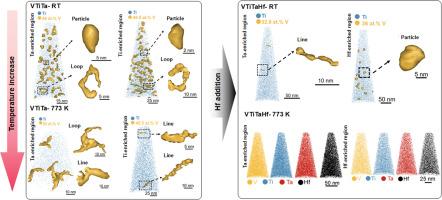辐照下V-Ti-Ta-(Hf)难熔高熵合金的显微组织演变:原子探针层析成像的温度效应
IF 14.3
1区 材料科学
Q1 MATERIALS SCIENCE, MULTIDISCIPLINARY
引用次数: 0
摘要
v - ti - ta基耐火高熵合金具有良好的耐辐照性能,被认为是下一代核电系统结构材料的有力候选者。然而,对其成分设计和温度依赖性辐照行为的综合研究仍然有限。采用纳米压痕和原子探针层析技术,系统研究了室温和773 K离子辐照下VTiTa和VTiTaHf合金的辐照硬化和显微组织演变。在VTiTa合金中,RT辐照导致富v颗粒和位错的形成,其数量密度和大小与局部成分变化密切相关。在773 K时,这些富v粒子消失,位错密度减小,平均尺寸增大。Hf的加入进一步抑制了RT辐照下富v粒子的形成和位错的发生。此外,在773 K时,VTiTaHf合金中元素保持原子尺度的均匀分布。这些显微组织变化与观察到的辐照诱导硬化行为一致,其中VTiTaHf合金在高温下表现出优异的耐辐射性。这些结果表明,Hf的掺入不仅提高了合金在高温下的辐照耐受性,而且有助于缩短放射性衰变周期,这是在核环境中应用的关键要求。本文章由计算机程序翻译,如有差异,请以英文原文为准。

Microstructural evolution under irradiation in V-Ti-Ta-(Hf) refractory high-entropy alloys: Temperature effects revealed by atom probe tomography
V-Ti-Ta-based refractory high-entropy alloys exhibit promising irradiation resistance and are considered strong candidates for structural materials in next-generation nuclear power systems. However, comprehensive studies on their compositional design and temperature-dependent irradiation behavior remain limited. In this study, irradiation-induced hardening and microstructural evolution of VTiTa and VTiTaHf alloys were systematically investigated under ion irradiation at room temperature (RT) and 773 K using nanoindentation and atom probe tomography. In the VTiTa alloy, RT irradiation led to the formation of V-enriched particles and dislocations, whose number density and size were closely correlated with local compositional variations. At 773 K, these V-enriched particles disappeared, the dislocation density decreased, and their average size increased. The addition of Hf further suppressed the formation of V-enriched particles and dislocations under RT irradiation. Moreover, an atomic-scale homogeneous elemental distribution was maintained in the VTiTaHf alloy at 773 K. These microstructural changes were consistent with the observed irradiation-induced hardening behavior, where the VTiTaHf alloy demonstrated superior radiation resistance at elevated temperatures. These findings suggest that Hf incorporation not only enhances the irradiation tolerance of the alloy at high temperatures but also contributes to reducing the radioactive decay period, which is a critical requirement for application in nuclear environments.
求助全文
通过发布文献求助,成功后即可免费获取论文全文。
去求助
来源期刊

Journal of Materials Science & Technology
工程技术-材料科学:综合
CiteScore
20.00
自引率
11.00%
发文量
995
审稿时长
13 days
期刊介绍:
Journal of Materials Science & Technology strives to promote global collaboration in the field of materials science and technology. It primarily publishes original research papers, invited review articles, letters, research notes, and summaries of scientific achievements. The journal covers a wide range of materials science and technology topics, including metallic materials, inorganic nonmetallic materials, and composite materials.
 求助内容:
求助内容: 应助结果提醒方式:
应助结果提醒方式:


